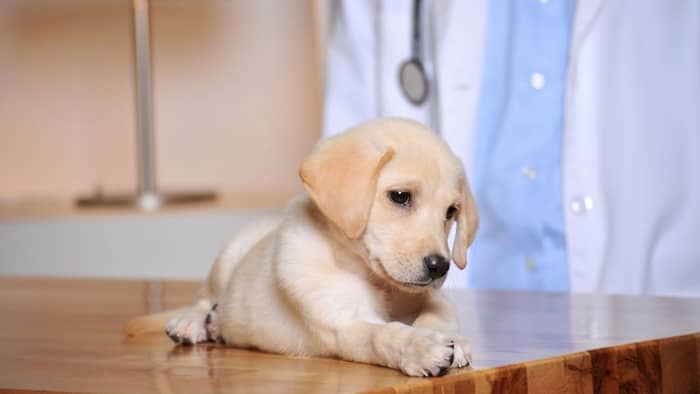Last Updated on September 22, 2023 by Linda Richard
Watching your puppy grow is both a wonderful and stressful experience. So, here’s a lab puppies growth chart and what you can expect. This should give you some insight into whether your pup is growing well and whether you should be worried about anything. Of course, this shouldn’t be used as an excuse to skip on your regularly scheduled routine vet visits.

Table of Contents
Interesting Facts!
The heaviest Labrador in the world, registered in Australia. Black male Sampson weighs 85 kg. However, due to the large weight, he cannot develop, he has shortness of breath and high speed. malnutrition occurs. The dog always lives in a shelter, and doctors treat him to lose weight in all available and safe ways.
Lab Puppies Growth Chart
So, how much and how fast do Labrador Retrievers grow? Here’s a detailed lab puppies growth chart for some insight into what the standard progression looks like:
| Labrador Retriever Age | Male Lab Average Height | Male Lab Average Weight | Female Lab Average Height | Female Lab Average Weight |
| 2 months | 8 to 12 in (20 to 30 cm) | 10 to 14 lbs (4.5 to 6.3 kg) | 7 to 10 in (18 to 25 cm) | 10 to 13 lbs (4.5 to 6 kg) |
| 3 months | 12 to 15 in (30 to 38 cm) | 22 to 26 lbs (10 to 12 kg) | 10 to 14 in (25 to 35 cm) | 20 to 26 lbs (9 to 12 kg) |
| 5 months | 15 to 18 in (38 to 46 cm) | 33 to 49 lbs (15 to 19 kg) | 12 to 15 in (30 to 38 cm) | 35 to 49 lbs (16 to 19 kg) |
| 7 months | 16 to 19 in (40 to 48 cm) | 51 to 59 lbs (23 to 27 kg) | 15 to 18 in (38 to 46 cm) | 40 to 55 lbs (20 to 25 kg) |
| 9 months | 20 to 23 in (51 to 58 cm) | 57 to 68 lbs (26 to 31 kg) | 20 to 22 in (51 to 56 cm) | 48 to 62 lbs (22 to 28 kg) |
| 11 months | 22 to 25 in (56 to 63.5 cm) | 62 to 75 lbs (28 to 34 kg) | 21 to 23 in (53 to 58 cm) | 53 to 66 lbs (24 to 30 kg) |
| 13 months | 22 to 25 in (56 to 63.5 cm) | 64 to 77 lbs (29 to 35 kg) | 22 to 23.5 in (53 to 59 cm) | 55 to 68 lbs (25 to 31 kg) |
| 15 months | 22 to 25 in (56 to 63.5 cm) | 64 to 80 lbs (29 to 36 kg) | 22 to 23.5 in (53 to 59 cm) | 55 to 70 lbs (25 to 32 kg) |
As you can see, the Lab puppies’ growth chart allows for quite a bit of deviation. If your puppy doesn’t fit perfectly in these parameters, that shouldn’t be an immediate cause for concern. However, it might be something you’d want to talk with your vet about to make sure you’re avoiding any and all dietary imbalances, that you’re not letting your pup get malnourished or overweight, and so on.
When Is A Lab Full Grown?
As far as their height is concerned, most labs will reach their adult height of 22 to 25 inches (56 to 63.5 cm) by their 11th month. They will also reach their optimal weight of 64 to 80 pounds (29 to 36 kg) by their 15th month. The reason behind those extra 6 months is that pups need some time to “fill up”, i.e build up some muscle, store up some (acceptable levels of) fat, and so on.
Don’t take this period to let your pup get overweight, of course. Labrador Retrievers are very food motivated, more so than quite a few other pups. Keeping your pup properly nourished is vital but letting your dog get fluffy is obviously ill-advised.
Labrador Breed Standards
Breed standards are considered to be:
• flat back, wide waist, deep chest;
• tail of moderate length, thick, gradually tapering towards the tip
• straight forelimbs with a long oblique shoulder;
• there are low-hopping joints of the hind legs, muscular and well developed;
• a large broad skull with a powerful blunt muzzle, fastening jaws and upright teeth;
• ears – hanging, but not heavy, located behind and closing to the head;
• powerful, strong neck;
• paws are rounded, with developed pads;
• thick, dense coat with charcoal undercoat, without feathering or waves;
• eyes are small, brown or light hazel, intelligent and pleasant.
• Color brown, black, as well as many shades of yellow: from light cream to bright red, the presence of a light (white) spot on the chest.
Does Neutering A Lab Puppy Slow Its Growth?
With lots of myths and misconceptions flying around the place, many people believe that neutering or spaying your lab puppy too early will slow down its growth. So, is that the case, does the lab puppies’ growth chart change at all after neutering or spaying?

Learn more about: When To Spay A Labrador Retriever?
There are thousands of studies done on this by this point and the main takeaway is that neutering or spaying doesn’t really change the growth of the puppy to any significant degree. There are some minor changes here and there, depending on the study, but nothing too significant.
In fact, many studies show that neutering/spaying before the 37th week or the 8th month even quickens the puppy’s growth. Neutering/spaying after that mark, on the other hand, sometimes have a very slight slowing effect on the growth. In either case, however, the difference isn’t very noteworthy.
How Can You Tell How Big A Lab Puppy Is Going To Get?
There are no guarantees when it comes to this but there are two ways you can look at:
- How big are the pup’s parents?
- How big is the pup compared to the rest of its litter?
Going off of those two signs and the averages for the breed we’ve detailed in the lab puppies growth chart above, you should get some overall idea about how big your puppy is going to get when it grows up.
Read more about: When Is A Labrador Puppy Full Grown?
FAQs
How long does it take a Labrador puppy to grow full size?
The average time it takes for a Labrador Retriever to reach its maximum height is about 11 months or less than a year. Some puppies take a bit longer and others do it even sooner. A few weeks of variation are to be expected as long as your vet is certain your pup is healthy. However, if your dog is way past its 1-year birthday and still hasn’t reached its expected adult, you should have a word with your vet.
As for the weight, this reaches its potential a bit later – around the 15th month. That’s because your pup will keep “filling in” even after it has reached its optimal height. Such “filling in” means muscule and only a bit of fat, of course – you don’t want your pup to start getting overweight.
How can you tell how big a Lab puppy will get?
Of course, there isn’t an exact science to this. The best we can do is look at a couple of things: 1) the pup’s parents and their height/weight; and 2) the rest of the litter and how the pup compares to its siblings. If the pup is near the average – neither the biggest nor the smallest of the bunch, then it will probably grow up to fit in the breed’s average size range and be close to its parents’ size.
If the pup is bigger than all its siblings, it will probably be closer to the breed’s maximum height and weight. It will also likely have a pretty dominant personality and require an experienced owner.
If the pup is the smallest of its litter, it will be near the lower end of the breed’s average. Some height problems also become more likely in this scenario so you shouldn’t skip your routine vet visits.
As for what the averages even are, for a standard Labrador Retriever, that’s 22 to 25 inches (56 to 63.5 cm) height at the shoulders and 55 to 80 pounds weight (25 to 36 kg).
How much do Lab puppies grow each week?
This will depend on the pup itself as well as the period/month you’re looking at. Between the second and third months, for example, you can expect a growth of a little less than an inch a week or ~2 cm. In terms of weight, a 3 pound (1.5 kg) a week is expected between the 2nd and 3rd month.
From there, the growth will gradually slow down until the puppy reaches its maximum height around the 11-month mark and its optimal weight around the 15th month.
How big is an 8 week old Labrador?
8 weeks or 2 months is usually the time most pups get adopted or purchased. It’s the perfect age as they are fully weaned off their mother’s milk, their sight and hearing are getting in check, and they can easily walk around and interact with the world. How big exactly is such a pup, however?
The average 8 week old Labrador should be somewhere between 8 and 12 inches tall at the shoulder (20 to 30 cm) with females being an inch or so shorter. As for their weight, that can vary between 10 to 14 pounds (4.5 to 6.3 kg), again – with females being a tad lighter.


2 thoughts on “Lab Puppies Growth Chart And What You Can Expect”
Comments are closed.